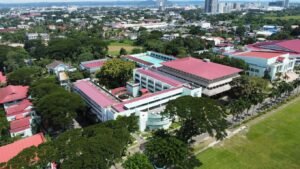- Central Philippine University
Overview, Fees, Life in institution & the place, Syllabus, Benefits
About Central Philippine University
 Academic Overview: Central Philippine University (CPU) offers a diverse range of undergraduate and graduate programs across various fields, including arts and sciences, business and accountancy, computer studies, education, engineering, hospitality management, law, medical laboratory science, nursing, pharmacy, and theology. The university emphasizes a blend of theoretical knowledge and practical skills, ensuring students are well-prepared for their careers.
Academic Overview: Central Philippine University (CPU) offers a diverse range of undergraduate and graduate programs across various fields, including arts and sciences, business and accountancy, computer studies, education, engineering, hospitality management, law, medical laboratory science, nursing, pharmacy, and theology. The university emphasizes a blend of theoretical knowledge and practical skills, ensuring students are well-prepared for their careers.
Founded in 1905 by American missionaries, CPU has grown into a prominent institution known for its pioneering role in nursing education in the Philippines. The university’s commitment to research and innovation is evident through its various research centers and institutes, which focus on areas such as agriculture, environmental science, health sciences, and social sciences.
CPU boasts a diverse and highly qualified faculty dedicated to providing quality education and mentoring. The university also offers extensive facilities and resources, including laboratories, libraries, computer centers, and sports facilities.
With a student population of approximately 15,885, CPU provides a supportive and dynamic learning environment. The university’s international collaborations offer students opportunities for global exposure and academic exchange.
CPU’s commitment to community engagement and social responsibility encourages students to participate in community service and outreach programs, contributing to societal development. Overall, Central Philippine University provides a holistic education that fosters academic excellence, research, and community involvement.
Key Information:
- Location: Jaro, Iloilo City, Philippines
- Established: 1905
- Type: Private, non-profit, research university
- Affiliation: Christian-Baptist
- Student Population: Approximately 15,885 (as of September 2023)
- Campus Size: Main campus in Jaro spans 24 hectares; additional campuses and lands total 167.7 hectares.
History and Background: Founded in 1905 by American missionaries of the American Baptist Foreign Mission Society, CPU began as the Jaro Industrial School. It was established through a grant from John D. Rockefeller. Over the years, CPU has grown into a prominent institution, playing a pioneering role in nursing education in the Philippines by establishing the first nursing school in the country.
- Current Statistics and Numbers:
- Students: Around 15,885
- Faculties: Diverse and highly qualified faculty members across various departments
- Departments: CPU comprises multiple colleges and departments, including the College of Nursing, College of Theology, College of Agriculture, Resources, and Environmental Sciences, among others.
Departments:
– College of Nursing
– College of Theology
– College of Agriculture, Resources, and Environmental Sciences
– College of Business and Accountancy
– College of Computer Studies
– College of Education
– College of Engineering
– College of Hospitality Management
– College of Medical Laboratory Science
– College of Pharmacy
– College of Law
– School of Graduate Studies.
Nearest Airport: Iloilo International Airport
Route Map: Delhi to Iloilo, Philippines
Duration: Approximately 8 hours (with layovers)
Average Flight Fare: Around 40 thousand INR
Central Philippine University is committed to providing quality education and fostering a nurturing environment for students, making it an excellent choice for those aspiring to pursue higher education in the Philippines.
Overview - Central Philippine University
| Accepted Examination | NEET Qualification |
|---|---|
| Total Course Fees | 20,00,000/- INR |
| University Ranking | Country – 20 |
| Course Duration | 5 years + 1-year internship |
| Medium of Instruction | English |
| Recognition & Accreditation | WHO, NMC, FAIMER, Commission on Higher Education (CHED) of the Philippines |
| Location | Jaro, Iloilo City, Philippines |
Fee Structure of Central Philippine University
Iloilo City from Indian student's perspective
Culture:
Language: Hiligaynon (Ilonggo) is the primary language spoken in Iloilo City, with English widely used in education and business. This makes it easier for Indian students to communicate and adapt.
Religion: The predominant religion is Roman Catholicism, but there are also various other Christian denominations and a growing number of other faith communities.
Hospitality: Ilonggos are known for their warm hospitality and friendliness, making it a welcoming environment for international students.
Arts and Entertainment: Iloilo City has a rich cultural heritage with numerous festivals, such as the Dinagyang Festival, showcasing traditional dances, music, and arts. The city also has theaters, galleries, and cultural centers.
Education: Iloilo is a hub for education in the Western Visayas region, home to several prestigious universities, including Central Philippine University, attracting students from across the globe.
Food:
Traditional Cuisine: Iloilo is famous for its local dishes like La Paz Batchoy (a noodle soup with pork, liver, and chicharrón), Pancit Molo (dumpling soup), and various seafood dishes.
Influence of Other Cuisines: Due to its diverse population, Iloilo also offers a variety of cuisines, including Filipino, Chinese, and Western dishes.
International Options: Indian students can find restaurants offering Indian cuisine, along with other international food options.
Street Food: The city’s streets are lined with food stalls selling local snacks like bibingka (rice cake) and puto (steamed rice cake).
Lifestyle and Other Relevant Information:
Climate: Iloilo has a tropical climate with a wet season (June to November) and a dry season (December to May). Indian students may find the weather similar to certain parts of India.
Transportation: Public transportation includes jeepneys, buses, and tricycles. Taxis and ride-sharing services are also available.
Cost of Living: The cost of living in Iloilo is relatively affordable compared to major cities in the Philippines and other countries, making it a budget-friendly option for students.
Recreation: Iloilo offers various recreational activities, including visiting historical sites, beaches, and parks. The Iloilo River Esplanade is a popular spot for jogging, walking, and socializing.
Safety: Iloilo is considered a safe city for residents and visitors, but it is always advisable to take standard precautions.
Why Study MBBS at Central Philippine University?
1. High-Quality Education: Central Philippine University (CPU) offers a robust medical education program that combines theoretical knowledge with practical skills, ensuring students are well-prepared for their medical careers.
2. English Medium Instruction: The MBBS program at CPU is conducted in English, making it accessible for international students, including those from India.
3. Affordable Tuition Fees: CPU provides medical education at reasonable tuition rates, making it an attractive option for students seeking quality education without the high costs associated with studying in Western countries.
4. Recognition and Accreditation: The MBBS degree from CPU is recognized by the WHO, NMC, and FAIMER, ensuring that graduates can practice medicine globally.
5. Experienced Faculty: The university boasts a team of highly qualified and experienced faculty members who are dedicated to providing personalized attention and guidance to each student.
6. Clinical Exposure: CPU offers extensive clinical training opportunities in well-equipped hospitals, allowing students to gain hands-on experience and practical skills essential for their medical careers.
7. Multicultural Environment: With students from various countries, CPU provides a multicultural environment that enriches the learning experience and broadens students’ perspectives.
8. Scholarship Opportunities: The university offers various scholarship programs to deserving students, helping to reduce the financial burden of medical education.
9. Comfortable Living Conditions: CPU provides on-campus hostel facilities and access to Indian food, ensuring a comfortable living experience for Indian students.
10. Extracurricular Activities: Students at CPU can actively participate in a range of cultural and extracurricular activities, enhancing their overall university experience.
MBBS Course Duration
The MBBS program at Central Philippine University spans a total of 6 years, which includes 5 years of academic education and 1 year of mandatory internship:
Academic Education: The first 5 years focus on providing students with comprehensive medical education, combining theoretical knowledge with practical skills. During this period, students engage in classroom learning, laboratory work, and clinical rotations.
Internship: After completing the 5 years of academic education, students must undergo a 1-year mandatory internship. This internship is conducted under the supervision of licensed doctors in affiliated hospitals, allowing students to gain hands-on experience and apply their knowledge in real-world medical settings.
Life in the Philippines from Indian students' perspective
Welcoming and Hospitable Culture
Warm Hospitality: The Filipino people are renowned for their warmth, friendliness, and hospitality. As an international student, you’ll find a welcoming environment where locals are eager to engage with foreigners.
Inclusive Atmosphere: The Philippines embraces diversity, making it easy for students from different backgrounds to adapt. You’ll feel included and part of a larger community.
Education System and Affordability
Quality Education: The Philippines has a well-established education system with several universities and colleges offering a wide range of programs. Many institutions provide English-medium education, which is advantageous for international students.
Affordable Tuition: Compared to other study abroad destinations, the Philippines offers affordable tuition fees. Indian students can pursue their academic aspirations without the burden of excessive costs.
Modern Amenities and Infrastructure
Urban Centers: Major cities like Manila, Cebu, and Davao offer modern infrastructure, including reliable transportation systems, internet connectivity, and amenities. You’ll find convenience and comfort in these urban centers.
Cultural Richness and Festivals
Cultural Diversity: The Philippines is a melting pot of cultures, traditions, and languages. Indian students can immerse themselves in a vibrant cultural scene, attending festivals, exploring local markets, and participating in traditional celebrations.
Festivals: From the colorful Sinulog Festival in Cebu to the lively Ati-Atihan Festival in Kalibo, there’s always something exciting happening. These festivals provide a glimpse into Filipino customs and folklore.
Safety and Security
Safe Environment: The Philippines is generally safe for residents and international students. While it’s essential to exercise caution, you can focus on your studies without major concerns about personal safety.
Natural Beauty and Outdoor Activities
Breathtaking Landscapes: The Philippines boasts stunning natural beauty, including pristine beaches, lush rainforests, and picturesque mountains. Indian students can explore places like Palawan, Banaue Rice Terraces, and Chocolate Hills.
Outdoor Adventures: Whether it’s snorkeling in crystal-clear waters, hiking to waterfalls, or surfing in Siargao, there’s no shortage of outdoor activities. The Philippines is an adventurer’s paradise.
Career Prospects and Networking
Growing Economy: The Philippines’ growing economy presents career opportunities for graduates. You can find internships, part-time jobs, and build a professional network during your studies.
In summary, life in the Philippines offers a blend of cultural richness, affordability, safety, and natural wonders. As an Indian student, you’ll discover a second home where you can thrive academically and personally.
Eligibility Criteria
Indian students applying for MBBS admissions in the Philippines must fulfill the following eligibility criteria:
- Academic Qualifications: Minimum 50% score in Physics, Chemistry, and Biology in Class 12 and passing marks in English. For reserved categories (SC/ST/OBC), a minimum of 40% in these subjects is required.
- Age Requirement: Attained the age of 17 as of 31st December in the admission year.
- NEET Exam: Cleared NEET exam with a minimum of 50th percentile for general/EWS category and 40th percentile for SC/ST/OBC category.
- NMAT Exam: Students must also clear the National Medical Admission Test (NMAT) as part of the admission process.
These criteria ensure that students are well-prepared and eligible to pursue their medical education in the Philippines.
Required Documents for MBBS Admission
- Passport
- Candidate's Recent Photographs
- Class 10 & 12 Marksheet
- NEET Scorecard
- Bank Statement
- PAN
- AADHAR
- Guardian's Declaration
- Covid Vaccination Certificate
- HBS Medical Certificate
Benefits of MBBS in the Philippines
Globally Recognized Degree: Medical degrees from the Philippines are recognized worldwide, including by the WHO, FAIMER, ECFMG, and the National Medical Commission (NMC) of India, allowing graduates to practice medicine globally.
Affordable Education: The Philippines offers affordable tuition fees for MBBS programs compared to many Western countries, making it a cost-effective option for Indian students.
Quality of Education: Medical universities in the Philippines provide high-quality education with a strong emphasis on practical skills alongside theoretical knowledge.
English Medium Instruction: Most medical universities in the Philippines offer programs in English, which is beneficial for Indian students as it eliminates the language barrier and makes it easier to adapt and learn.
Cultural Experience: Studying in the Philippines allows students to experience a new culture and lifestyle, broadening their horizons and contributing to personal growth.
Research Opportunities: The Philippines’ focus on scientific research provides students with opportunities to engage in innovative medical research projects.
Clinical Exposure: Medical students in the Philippines receive extensive clinical training, with opportunities to practice in well-equipped hospitals.
Scholarship Opportunities: Various scholarship programs are available for international students, which can further reduce the financial burden of studying abroad.
Safety and Living: The Philippines is known for its safe environment and offers a comfortable living experience for students, with a relatively low cost of living.
These benefits make the Philippines an attractive destination for Indian students to pursue an MBBS degree, combining quality education with affordability and international recognition.
MBBS Syllabus:
1st year
- Human anatomy
- Molecular biology and Genetics
- Histology and Embryology
- ICT
- Foreign Language (Latin)
- Kazakh (Russian) language
- Modern History of Kazakhstan
- Fundamental Law and Anticorruption Culture
- Physical Education
- Internship (Nursing Assistance)
2nd year
- Morphology and Physiology
- Human Anatomy
- Microbiology
- Biochemistry
- Philosophy
- Sociology and Political Science
- Professionally Oriented Foreign Language
- Physical Education
- Internship (Procedural Nurse Assistance)
3rd year
- General Pathology
- Preventive Social Medicine (PSM)
- Introduction to Clinical Medicine
- Biochemistry
- Psychology and Culturology
- Pathology of Organs and System
- Immunology
- Introduction to Pediatrics
- General Medicine
- Internship (Nursing Practice)
4th year
- Pharmacology
- Community Medicine
- Introduction to Clinical Medicine
- Introduction to Surgery
- Implementation of Big Data Medicine
- Dermatology
- Gynecology
- Obstetrics
- Neurology
- Urology
- Pediatrics
- Psychiatry
- Infectious Disease
5th year
- Necrology
- Cardiovascular System
- Anesthesiology
- Health Information System and E-Health
- Fundamental of General Medical Practice
- Surgery
- State Examination (Specialty term)
6th year
- Internship
FAQ
MBBS abroad is a better options then private medical in India, especially in terms of cost, private medical in India costs a fortune more then that of many countries abroad.
Expertise: Rare Education have years of experience and in-depth knowledge about the admission process, eligibility criteria, fees, and other requirements for pursuing MBBS abroad. We can guide you through the entire process and help you avoid common mistakes and pitfalls.
Time-saving: The admission process for MBBS abroad can be complex and time-consuming. Working with Rare Education can help save a significant amount of time as we can handle all the paperwork and follow-up for you.
Access to information: Rare Education have access to a wide range of information about various medical schools, their fees, and programs. We can help you compare and choose the best options based on your needs and budget.
Professional guidance: Rare Education can provide professional guidance on the best country and medical school to choose based on your academic background, personal interests, and career goals. We can also help you with the visa process, travel arrangements, and settling into your new surroundings.
Support throughout the Process: Rare Education provide ongoing support throughout the entire admission process and beyond. We can answer any questions you have, provide updates on your application status, and help resolve any issues that may arise.
Working with Rare Education for MBBS abroad admission can provide numerous benefits, including expertise, time-saving, access to information, professional guidance, and support throughout the process.
Comparing FMG exam with NEET, we can safely say it is not at all a tough exam. Although there are no specific matrix to judge how tough an exam is, but considering the passing ratio of FMG exam which is roughly 20-25% to that of the percentage of candidates who get selected for government medical college through NEET which is roughly 0.02%, FMG exam is definitely a tough exam in the field of medical studies.

